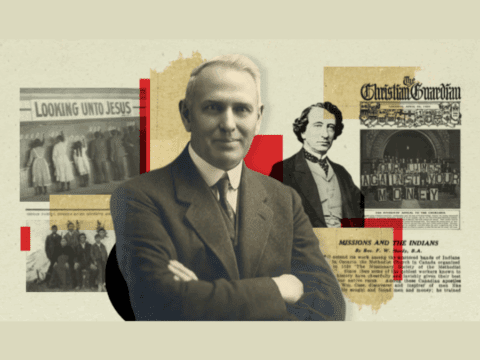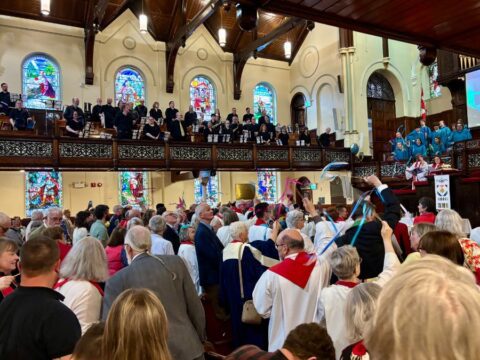During a November meeting filled with presentations, discussion, prayer and closed-door consultations, the Executive of General Council determined that a move out of the Greater Toronto Area (GTA) would result in too-high severance and relocation costs. Instead, members voted unanimously to lease office space in buildings being developed by one of two Toronto United churches: Bloor Street United or Metropolitan United.
Both historic downtown churches have ambitious redevelopment plans, and both have yet to begin construction. The General Council’s current lease in a west Toronto office tower expires in 2015, so the Executive’s decision calls for a move “within the next 10 years” and allows for an interim extension of that lease or a move to temporary quarters.
General Council’s process of discussing issues in table groups meant there was little open debate over the decision. But with financial reports showing declining donations and escalating fixed expenses, Executive members were well aware that a move out of Toronto — estimated to cost up to $11 million in staff severance and relocation payments — would have put additional pressure on future budgets.
Cost alone seemed to dampen much of the enthusiasm expressed at previous meetings for relocating to Winnipeg. For those who favoured a move to Manitoba’s capital, leasing space in a church-affiliated building in Toronto seemed like an acceptable second choice because it moves the headquarters out of its current location in a corporate high rise.
“Our table group felt the symbolism of the move is really important to our health as a church,” said Rev. barb janes of Winnipeg, who attended the meeting. “We suggested the option of staying in this place, to buy time to allow the downtown churches to flesh out their proposals fully. But we didn’t want to lose that important symbol of who we are as a church.”
When they met last May, members of the General Council Executive agreed to receive office bids from anywhere in Canada, not just Toronto. The accommodations working group issued a formal request for proposals last summer and received 17 pitches, ranging from vague plans to existing buildings. Two proposals came from Winnipeg, and the rest were from Ontario, including a redevelopment project
at the Anglican Cathedral in Ottawa and a former school building in North Bay, Ont.
Opening up the competition showed how many communities and congregations value the General Council Office, said Louise Rogers of Sherwood Park, Alta., co-chair of the accommodations working group. Hearing their presentations was “a lot of work and a blessing. . . to know that people were ready and wanting to welcome us.”
The proposal with the most polished and comprehensive community effort was Winnipeg’s. Supported by Manitoba and Northwestern Ontario Conference, the proposal was organized by a city promotion and development consortium called Yes! Winnipeg, and promised to bring “radical transformation” to the church.
The group backed specific building proposals and produced a $25,000 online video featuring former moderator Very Rev. Stan McKay; Flor Marcelino, a United Church member and Manitoba’s minister of heritage, tourism and multiculturalism; and Lloyd Axworthy, a United Church member and former federal cabinet minister who is now president of the University of Winnipeg.
After receiving the bids, the accommodations working group hired a leasing consultant to help them evaluate the 13 most likely proposals. Their findings were published in a 15-page report that compared each proposal’s total present value (a dollar figure that adds up costs and subtracts discounts over 10 years to allow different projects to be compared fairly), average yearly rent, access to public transit, archives space, meeting space, environmental standards and sacred space.
Estimated 10-year costs ranged from $8.8 million (for an existing building near Toronto Pearson Inter- national Airport) to $17.2 million (for the proposed Anglican Cathedral Hall project in Ottawa). The church-related downtown Toronto projects were in the middle of the pack, with Metropolitan United at $12.26 million and Bloor Street United at $12.64 million. Winnipeg’s two proposals came in at $11.9 million and $11.7 million.
However, said leasing specialist Randy Borron of Cushman & Wakefield Ltd., “Cost is only one thing in making a decision. Where you are and how you function and how you collaborate is another thing.”
For the Executive, the effect of an out-of-town move on General Council’s 174 staff was a major factor. Surveys and discussions with them showed most would not relocate outside the GTA.
General secretary Nora Sanders, who discussed staffing with Executive’s voting members in a closed-door session, said later, “If we made a significant move . . . we would largely be creating a new staff.” As well, severance and relocation payments would be at least $5.1 million and as much as $11 million.
In the end, Executive members were asked to vote on one of four options: renewal of the current lease or equivalent, including buildings in Mississauga and near the airport; a significant geographical move to North Bay, Winnipeg or Ottawa; downtown Toronto offices including Bloor Street United, Metropolitan United and West Don Lands; and offices in Kitchener-Waterloo, Ont., and Guelph, Ont.
By the third day of the meeting, it was clear downtown Toronto was the top choice; Executive members opted to seek transformation without relocation. “Transformation needs to come from within, not from the address of the national office of the church,” said Rev. Mary Royal of Vermilion, Alta.
In an interview after the decision, Manitoba and Northwestern Ontario Conference executive secretary Rev. Bruce Faurschou expressed disappointment that Winnipeg was not chosen. “We think we had a great vision for the church,” he said. “We think it was a transformative vision. The rest of the family never saw it that way. So that’s fine.”
Within a week of the Executive’s decision, church staff began negotiations with Metropolitan United and Bloor Street United. A choice between the two finalists could be made at the next Executive meeting in March or at an earlier meeting of the sub-Executive.
Metropolitan United’s proposed project is a $120-million, 37-storey office and apartment tower to be built on land leased from the Queen Street East church; the church’s sanctuary and offices will remain in a separate building. Called The Metropolitan, it will feature 60,000 square feet of office space on the four bottom floors and 442 rental apartments in a tower above. More than a decade in the making, The Metropolitan already has its design, building permits, zoning, bylaws and heritage permits in place. Once financing and a final agreement with Lancer Development Ltd. are worked out, construction would take about three years, and the building could be ready when General Council’s current lease expires.
Bruce Peckover, a trustee at Metropolitan, says the 395-member congregation is keen on completing the project and having the General Council Office next door but prefers to let committees do their work with little interference. “We have the excitement too,” says Peckover, “because the project means a complete renewal of everything that surrounds us.”
After seeing the request for proposals last summer, Bloor Street United’s congregation decided to tie its current redevelopment plans to a General Council Office proposal. The church’s project is still in the works, but will include a renovation of its sanctuary, meeting rooms and offices. The four bottom storeys would provide 40,000 square feet of office space for the General Council, and condominiums would be built above them. A separate building, owned by Bloor Street United but currently housing The Observer offices, would likely remain in place as a buffer between the new development and its residential neighbours.
“I think the excitement is still there,” says Michael Hilliard, chair of Bloor Street’s development committee. The 332-member congregation has been weighing redevelopment of its Bloor Street West site for more than a decade, but plans shifted into high gear last fall when its development partner, Northrop Development Inc. of Mississauga, Ont., released preliminary design drawings. The final cost of the project will depend on design and construction details, but Hilliard says the congregation’s land and buildings, worth an estimated $20 million, would provide a financial backstop.
With no permits, zoning changes or heritage permissions in place, Hilliard cited 2016 as a likely move-in date.
Both potential office sites are near subway stations, and both churches are planning buildings that will meet high environmental standards.
“Both Met and Bloor Street have compelling stories to tell,” says Peckover. “And it’s going to be challenging for the church to decide which way to go.”














